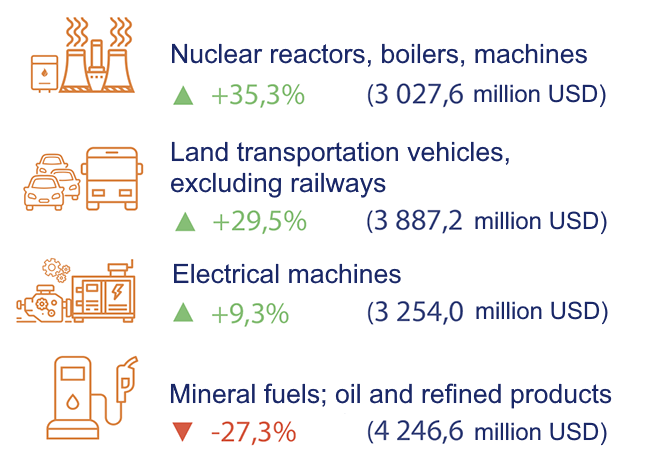
In 2024-2028, the Swiss Agency for Development and Cooperation (SDC) will allocate 58.7 million francs for the digitalization and development of Ukrainian regions, including the digitalization of healthcare, education, humanitarian demining, and electronic notary.
According to Mykhailo Fedorov, Deputy Prime Minister for Innovation, Education, Science and Technology and Minister of Digital Transformation, this is stipulated in a memorandum signed on Wednesday.
“I met with Felix Baumann, Ambassador of Switzerland to Ukraine. The main result of the meeting is the signing of a memorandum for 58.7 million francs ($68.1 million) with the Swiss Agency for Development and Cooperation (SDC),” Fedorov wrote in a telegram.
According to him, the funds will be allocated during 2024-2028 and will be used for the digitalization and development of Ukrainian regions, with projects implemented under the EGAP program implemented by the Eastern Europe Foundation. “We are focusing on the digitalization of healthcare services, electronic notary, education, humanitarian demining, and we continue to restart the State Statistics Service. Part of the funds will be used to support the frontline regions, and it is important to ensure access to public services in every community,” Fedorov listed the areas of use of the funds.
Fedorov recalled that with the support of the Swiss government, in 2024 alone, they launched an online marriage and a pilot of the Mriya project for 40 schools, and began testing Diia for civil servants. “We held another international Diia.Summit in Zurich, strengthening the international brand of digital Ukraine. It was there that we signed a memorandum on the opening of the Govtech center together with the World Economic Forum,” said Fedorov.
In general, Switzerland has been supporting digitalization since 2015 through the EGAP program, with partners allocating more than 30 million francs.
Dynamics of import of goods in Jan-June 2024 by most important items in relation to same period of 2023, %

Open4Business.com.ua

JSC Slavic Wallpaper-KFTB (Koryukivka, Chernihiv region), a leading Ukrainian wallpaper producer, produced 11.2 million conventional pieces of wallpaper in January-August 2024, up 3.9% compared to the same period in 2023.
According to statistics provided by Ukrpapir Association to Interfax-Ukraine, the company’s output growth rate slowed further in the first eight months of the year compared to the same period last year: it was 8.9% in the first six months and 6.8% in the first seven months.
Also, in monetary terms, the factory’s production volume in January-August increased by 2% to UAH 851.5 million.
In August, the company produced 1.32 million meters of wallpaper, which is 13.8% less than in August-2023 and 15.8% less than in July this year.
The EBA has no data on wallpaper production in Ukraine in January-August 2024, as the State Statistics Service has stopped providing it.
As reported, in 2023, Slavic Wallpaper-KFTB increased its wallpaper production by 19% compared to 2022, to 16.2 million meters, production volume increased by 38.2% to UAH 1 billion 249 million, and net profit increased almost eightfold to UAH 47.7 million.
Earlier, the company noted that as a result of Russian aggression, sales volumes, especially through retail channels, had significantly decreased.
JSC Slavic Wallpaper-KFTB produces more than 10 types of wallpaper from the economy segment (paper, duplex, acrylic) to premium wallpaper (vinyl, non-woven, hot stamped).
In addition, the factory produces its own latex, water-dispersion paint under the Latex brand.

Ukraine exported 2.24 mln tons of wheat in August of this year (2024-2025 marketing year), the Ukrainian Grain Association (UGA) reported on Facebook.
According to the published infographic, 492 thousand tons of wheat were shipped to Spain, 426 thousand tons to Indonesia, 240 thousand tons to Vietnam, 191 thousand tons to Algeria, and 146 thousand tons to Egypt. Thailand (96 thsd tonnes), Portugal (82 thsd tonnes), Yemen (61 thsd tonnes), Tunisia (79 thsd tonnes) and Italy (68 thsd tonnes) also became the top 100 buyers of Ukrainian grain.

“Interestingly, in August, Indonesia and Vietnam took the 2nd and 3rd place in terms of imports of Ukrainian wheat, pushing Algeria and Egypt to the 4th and 5th place, respectively,” the association noted.
According to the UGA, Ukraine exported 1.277 mln tons of wheat in the first half of September, which is already higher than the volume for the same period last month, when it amounted to 1.266 mln tons.

As of September 20, farmers in all regions of Ukraine have harvested 44.5 million tons of new crops from 12.5 million hectares, up from 39 million tons from 10.9 million hectares a week earlier.
As reported by the Ministry of Agrarian Policy and Food on Friday, 31.9 million tons (30.08 million tons) of grain, 11 million tons (8.2 million tons) of oilseeds and 1.7 million tons (741.5 thousand tons) of sugar beet have already been harvested.
It was specified that the harvest of wheat has been completed, with 22.3 million tons harvested from 4.9 million hectares at a yield of 42.4 c/ha, barley – 5.5 million tons from 1.41 million hectares at a yield of 39.2 c/ha, peas – 465.3 million tons from 212.2 thousand hectares at a yield of 21.9 c/ha.
Corn harvesting continues, with 2.4 million tons harvested (255.3 thousand tons a week earlier) from 514 thousand hectares, buckwheat – 99.4 thousand tons (88.2 thousand tons) from 66 thousand hectares, millet – 132 thousand tons (110.43 thousand tons) from 132.0 thousand hectares.
Ukraine continues to harvest oilseeds. In particular, 3.4 million tons (3.415 million tons) of rapeseed have been harvested from 1.265 million hectares, 2.6 million tons of soybeans (1.845 thousand tons) from 1.3 million hectares, and 4.9 million tons (1.5 million tons) of sunflower from 2.4 million hectares.
The leaders in grain harvesting are farmers in Odesa region, who threshed 4.1 mln ha, Poltava region – 2.4 mln tons, and Vinnytsia region – 2.3 mln tons. In terms of yields, Khmelnytsky region is ahead with 63.4 c/ha, Ivano-Frankivsk region – 58.6 c/ha, and Ternopil region – 57 c/ha.

A Boeing 737-800SF from the fleet of Supernova Airlines of the NOVA Group (Nova Poshta) has completed its first flight between European airports, the press service of the NOVA Group reports.
“On September 18, 2024, Supernova Airlines made the first flight on its own Boeing 737-800SF aircraft flying the flag of Ukraine, with Ukrainian registration marks UR-NPA. This was a certification flight, one of the final steps in the process of introducing the Boeing 737-800SF type to Supernova’s operator certificate by the State Aviation Administration of Ukraine,” the NOVA press service said.
The airline plans to start regular commercial operation of the aircraft in the winter season of 2024-2025.
Earlier, a Boeing 737-800 from Supernova’s fleet operated a maintenance flight from Guangzhou (China) to Vilnius (Lithuania) with a technical stop at Tashkent Airport.
The company clarified that the use of air transportation saves up to 36 hours on the delivery of parcels from (or to) Riga compared to trucks. It was also reported that Supernova Airlines plans to form a fleet in the future using cargo versions of modern aircraft manufactured by Boeing or Airbus.
Supernova Airlines has received a Ukrainian operator’s certificate, which allows it to start cargo flights on January 6, 2023.